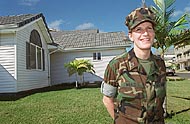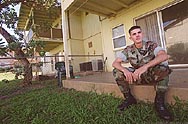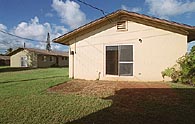By Mike Gordon
Advertiser Staff Writer
Now that she’s living in a roomy new home, with its enclosed garage, modern amenities and air conditioning, Marine Staff Sgt. Sandra Weiss can laugh about her 18 months in the worst military housing she had ever seen.
 |
| Staff Sgt. Sandra Weiss is happier with her new living quarters at the Hawaii Loa Housing on the Marine Corps Based Hawaii at Kane‘ohe.
Bruce Asato • The Honolulu Advertiser |
Cochran Housing, on the Kailua Bay side of Marine Corps Base, Hawai‘i, was built in the early 1960s. It was old before Weiss was born; she’s 25.
"It had been painted over so many times but the paint just peels off," she said. "You’re always having to sweep up the paint chips. And the bugs..."
Weiss rolled her eyes.
"Oh, the bugs were just terrible," she said. "It didn’t matter how much you cleaned. They would be crawling all over the floor when you woke up in the morning."
Cochran stands, although for only a few more weeks, as an extreme example of the dilapidated state of military housing in Hawai‘i.
Although new homes open every year — Weiss’ complex opened in 1998 — military leaders must grapple with the reality that much of the basic inventory is not aging gracefully. Many of the homes are 20 to 40 years old.
Commanders everywhere are under 1997 Pentagon directive to upgrade all their homes to modern standards by 2010. Some already had a head start when the orders came: In the past 10 years, more than 3,300 new homes were built in Hawai‘i and more than 3,500 refurbished.
But the challenge is daunting, the task far from complete.
 Many of the Mokapu Peninsula homes at Marine Corps Base Hawaii are 30 years old and salt-laden tradewinds have even etched holes in cinderblock walls, like those in Cochran. There is no more room on base for additional homes. Many of the Mokapu Peninsula homes at Marine Corps Base Hawaii are 30 years old and salt-laden tradewinds have even etched holes in cinderblock walls, like those in Cochran. There is no more room on base for additional homes.
 Only 15 percent of the Army’s 7,783 homes were built after 1990. About 2,500 others have been refurbished, at a cost of $43 million. Only 15 percent of the Army’s 7,783 homes were built after 1990. About 2,500 others have been refurbished, at a cost of $43 million.
 |
| Old apartments, right, at the Navy’s Hale Moku housing off Pearl Harbor will make way for new homes like the ones across the street.
Bruce Asato • The Honolulu Advertiser |
 At Hickam Air Force Base, extensive remodeling was chosen over building new homes and officials have completely refurbished 334 homes since 1996. In some, bedrooms were consolidated to increase their size. At Hickam Air Force Base, extensive remodeling was chosen over building new homes and officials have completely refurbished 334 homes since 1996. In some, bedrooms were consolidated to increase their size.
 The Navy has been working for the past seven years on a program to replace 3,785 homes — nearly half its inventory — and remodel 976 more. The bill so far: $347 million. The Navy has been working for the past seven years on a program to replace 3,785 homes — nearly half its inventory — and remodel 976 more. The bill so far: $347 million.
The military is well aware of what is at stake: Quality of life is a major retention issue among the ranks.
And the quality begins at home.
"That’s the No. 1 thing, especially for the Navy and Marines because they go on long deployments," said Jared St. John, deputy assistant chief of staff for Navy family housing in Hawai‘i. "Before, they put them into those cookie-cutter homes and said, ‘Be happy.’ They didn’t look at what made a neighborhood a community."
As the Navy re-made its neighborhoods, it appears that parks, playgrounds and community centers have taken on more prominent roles.
The Navy has done extensive remodeling of older homes, but St. John said new homes are preferred. In the Navy’s Hokulani Housing Area, 190 units built in the 1970s were gutted and remodeled.
"The work they did was great," St. John said. "What we don’t like is it is the same old neighborhood and the sewer lines are 30 years old. They back up."
Among the Navy homes, the most striking contrast between old and new is along Center Drive, which draws a black-top boundary through the Hale Moku housing project.
On one side are homes built in the 1940s and on the other are homes still waiting for their first occupants. Navy officials dedicated 318 of the new homes in March. Another 134 will finished sometime next year.
The old homes form a ghost town shaded by towering trees with enormous, foundation-cracking roots. The homes are small, run-down. President Jimmy Carter lived here when he was Navy submariner; his former home has already met with a bulldozer.
 |
| Cpl. Roman Yurek appreciates his Ulupau townhouse at the Marine base in Kane‘ohe. He has close access to the beach, central air conditioning and good neighbors.
Bruce Asato • The Honolulu Advertiser |
The new ones showcase a growing standard in military housing: wooden cabinets, Corion countertops and steel framing to battle termites. They also feature ceramic tile entryways and linoleum floors but the Navy plans to build the final phases with laminated wood flooring and carpet, St. John said.
All of the homes are for junior enlisted sailors and their families. Because these homes are so nice, some Navy officials have asked what kind of housing will be provided for senior officers, St. John said.
"It used to be that rank had its privileges," he said. "But the quality won’t be any difference. Only size."
The waiting list for a brand new home is considerable, with families waiting as much as a year, St. John said.
"But if you want the old, ugly home with no air-conditioning, we can get you in today," he said.
The Army has watched its waiting list fall from about 1,000 families in 1990 to about 250 currently. Hawai‘i’s tough economic times lowered the price of rentals, so families headed out with a monthly housing allowance that ranges from $1,109 to $1,699.
At Schofield Barracks, the Army has a lot of homes right off the set of "From Here to Eternity," giving the post the feel of another era.
But many of the older homes were built in the early 1960s from a floorplan that can be found on nearly every military installation in the country. They are boxy, with flat roofs and linoleum floors and suffer from paint jobs in faded shades of yellow and pistachio.
To focus only on appearance would only be half the story.
Maj. Brad Scwhartz, a physician at Tripler Army Medical Center, lives in Aliamanu Military Reservation and says the military is a good landlord.
"Generally speaking, when you live in military housing, you have a sense of security and a sense of safety, and I think you have a sense you will be taken care of," he said.
"If the air-conditioning goes out or the refrigerator breaks, you can call people 24 hours a day."
And given the high cost of renting in the community, military homes are a blessed alternative, he said.
 |
| Homes in housing area FY63 at the Kane‘ohe Marine base need repairs. Salt from the nearby ocean is blamed for contributing to the deterioration. The wall on this unit needs to be rebuilt with hollow tile.
Bruce Asato • The Honolulu Advertiser |
"I think all of us feel lucky we can live somewhere for free," he said. "In the economy here, things tend to be expensive and the homes you get are not built that well."
Chief Warrant Officer Monty Meston had heard all the horror stories about military housing before he moved into his brand new four-bedroom home earlier this month at Schofield Barracks.
The home was one of 64 that opened last fall. The quiet street curves around a playground shaded by tall monkeypod trees.
"These are beautiful accommodations, especially compared to what we saw here," Meston said. "This is phenomenal. Go across the street and they’re atrocious."
But of all the locations of military home in Hawai‘i, you could argue that the nicest one isn’t assigned to an admiral or a general.
For now, it belongs to Navy Lt. Cmdr. Alan Shaffer and his wife and children.
They live in a 1960s home perched on a bluff at the far end of M¯kapu Peninsula. Termites have chewed on it. If they leave the windows open, everything they own quickly gains a salty patina.
When they toured it for the first time, they thought it was a little small.
They knew they would have to buy an air conditioner — a common practice in military housing — and carpet to cover the tile in the livingroom.
"When you move from home to home, you learn to expect 1940s-style basic housing," Sandra Shaffer said.
Her husband nodded vigorously.
"You just hope that when you drive up to see it that it’s acceptable," he said. "A pretty tree, maybe. A lawn."
But when they look out the window over their kitchen sink, this is what they see: the white sand of North Beach, shore-hammering waves, breaching humpback whales, the blue edge of the world.
"We know there is a lot of luck of the draw," Alan Shaffer said, just before he smiled.
Maybe, but KP never looked so good.
[back to top] |

